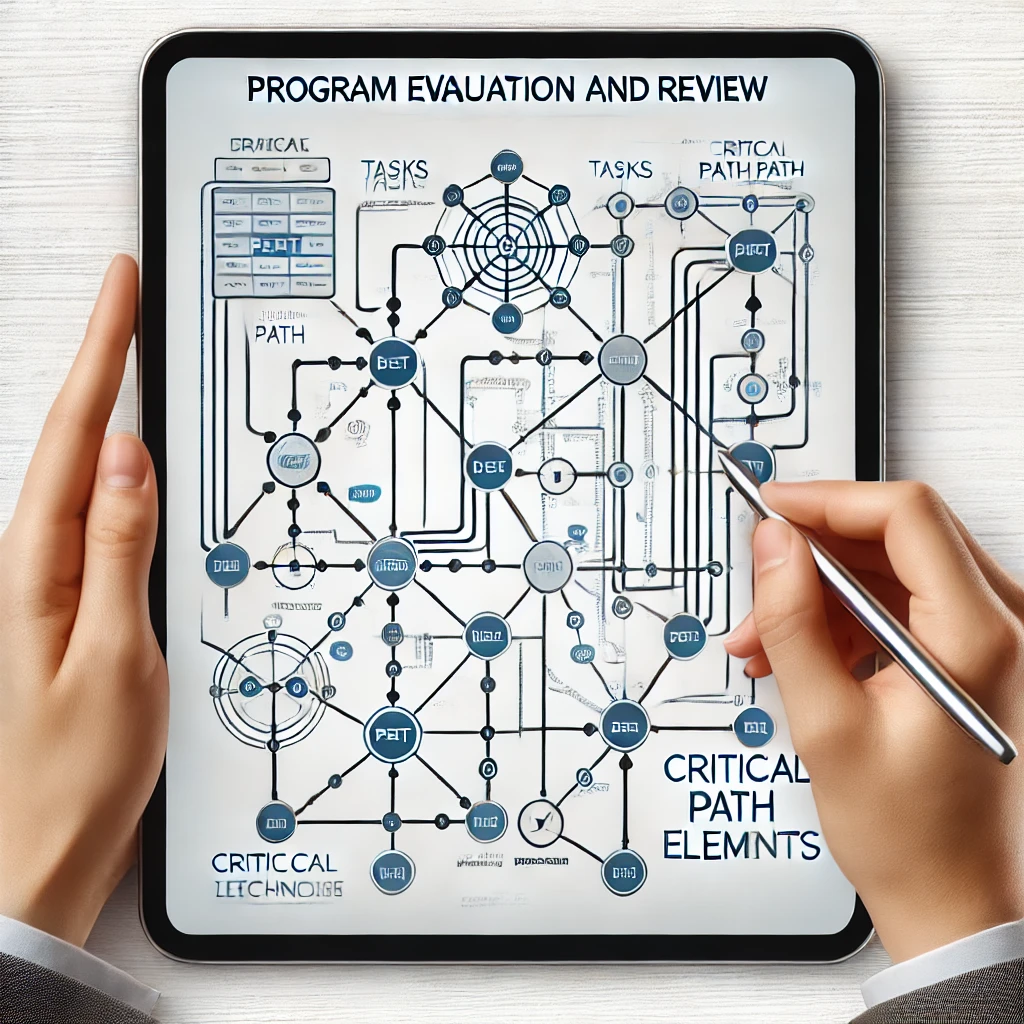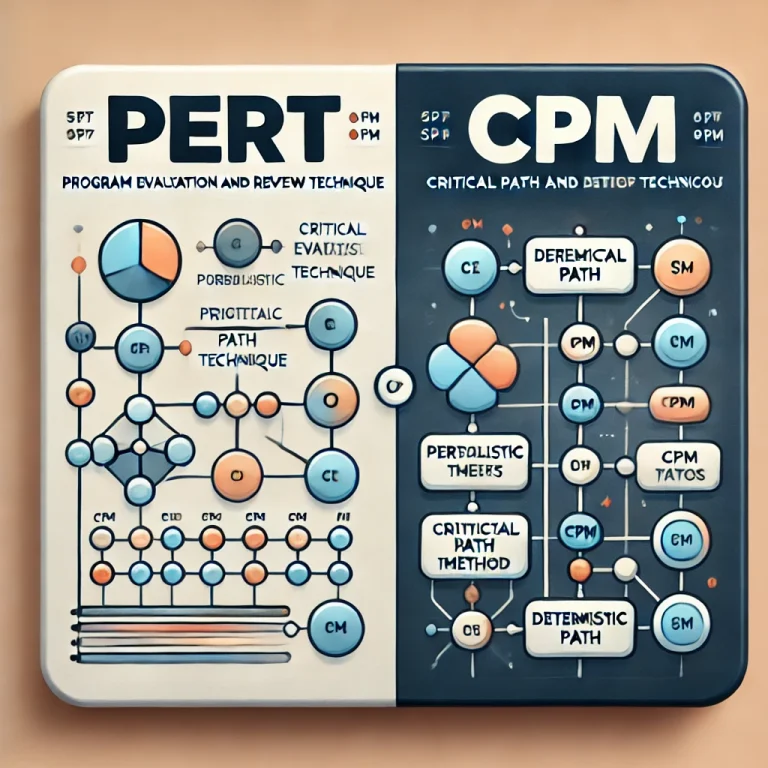The difference between PERT and CPM lies mainly in their approaches to project management. Both are project scheduling techniques that help in planning and controlling the various tasks necessary for completing a project. While PERT is mainly used for projects with uncertain time estimates, CPM is often used for projects with well-defined tasks and predictable timelines. It digs into the differences, characteristics, and uses of PERT and CPM to make it easier to understand when and how each is used in project management.

What is PERT?
The Program Evaluation and Review Technique, commonly referred to as PERT is a project management tool used for scheduling, organizing, and coordinating activities within a project. Developed initially in the 1950s by the U.S. Navy, it was used to manage large projects with high uncertainty.
- Uncertainty Management: PERT is used for projects where activities are not properly described and completion times are uncertain. In case of PERT, the expected time for each activity is calculated by estimating the probable time, optimistic time, and pessimistic time for that activity.
- Probabilistic Approach: It uses three time estimates—optimistic, pessimistic, and most likely—for every task, making it applicable for projects with unpredictable or experimental activities.
- Network Diagram: PERT charts or network diagrams are useful in visualizing the workflow of a project, identification of dependencies, and finding the longest path of dependent tasks, which is referred to as the critical path.
- Risk Assessment: As PERT gives several time estimates, it clearly presents a view of the risks and potential delays, and hence managers can prepare better for the uncertainties.
What is CPM?
The Critical Path Method (CPM) is a project management technique focused on determining the sequence of tasks that directly affect the project’s duration. It was developed around the same time as PERT in the private sector and is popularly used in construction and engineering projects with repetitive tasks and well-defined time estimates.
- Deterministic Approach: The time is calculated only once for all activities in a project under the CPM system, whereas that is not so in PERT. Hence, it is applied to those projects that possess absolute deadlines and uncertainties to be at a minimum.
- Identification of Critical Path: The network path with the maximum length shows the shortest time possible to accomplish the project. Tasks found in this path do not possess any slack time. Hence, should there be a delay, the whole project suffers.
- Resource Allocation: It is apt for resource optimization in any task where it follows sequential and predictable orders.
- Cost Control: The system basically concentrates on task durations, which are more or less used in preparing budgets as well as in cost controlling. It also determines ways of achieving projects that take the least cost to attain a given output.
Difference Between PERT and CPM
| Aspect | PERT | CPM |
|---|---|---|
| Definition | Program Evaluation and Review Technique | Critical Path Method |
| Nature | Probabilistic, used for uncertain projects | Deterministic, used for predictable projects |
| Time Estimates | Uses three estimates: optimistic, pessimistic, and most likely | Uses a single fixed time estimate per task |
| Risk Factor | High-risk factor, due to uncertain time estimates | Low-risk, given fixed time estimates |
| Focus | Time and cost-oriented focuses on efficiency | Time and cost-oriented, focuses on efficiency |
| Application | Research and development, and innovation projects | Construction, engineering, and manufacturing |
| Flexibility | High flexibility in timelines | Lower flexibility, with emphasis on schedule adherence |
| Critical Path | Changes as per activity duration | Usually remains fixed due to set timeframes |
| Cost Consideration | Less focus on cost | Strong focus on minimizing cost and time |
Benefits of Using PERT and CPM
Using PERT and CPM provides distinct benefits that support effective project management:
Benefits of PERT
- Enhanced Risk Management: It helps the project manager to predict the delays that are likely to arise and hence, set even more realistic project timelines.
- Flexibility: It has a flexible structure that goes well with research-oriented projects and innovative ones with untimely frames.
- Clear Visual Representation: It simplifies complicated structures of a project. It helps the teams to understand the dependency and do things accordingly.
Benefits of CPM
- Cost and Time Efficiency: CPM also emphasizes resource optimization and getting things done in terms of budget and time constraints.
- Project Monitoring: Based on the critical path identification, CPM is useful for monitoring and controlling key milestones within the project.
- Systematic Approach: With defined time milestones, CPM allows a structured approach that works well for large, resource-oriented projects.
Similarity Between PERT and CPM
Despite their differences, PERT and CPM share several similarities:
- Network Diagrams: Both utilize network diagrams to represent tasks and their dependencies.
- Critical Path Identification: Both have identified a critical path, which determines the minimum duration of the project.
- Project Scheduling: Both are used as basic tools in scheduling and managing projects with a focus on optimizing task efficiency and time.
- Resource Management: Both approaches assist in planning and managing resources so that projects do not go off track.
The difference between PERT and CPM helps project managers choose the right tool based on the nature and requirements of the project. PERT is useful for projects that have high uncertainty, and CPM is useful for well-structured tasks that have predictable timelines. Most of the time, it is a combination of both PERT and CPM, which balances flexibility with control to optimize both time and cost efficiency.
PERT and CPM FAQs
What is the primary difference between PERT and CPM?
PERT uses a probabilistic approach suitable for uncertain projects, while CPM uses a deterministic approach ideal for projects with well-defined timelines.
Can PERT and CPM be used together?
Yes, they can be combined for projects that need both flexibility in uncertain tasks and control over predictable activities.
Which is more suitable for construction projects, PERT or CPM?
CPM is generally more suitable for construction projects due to its focus on time and cost efficiency with well-defined tasks.
Is CPM cost-effective for research projects?
No, CPM is less suited for research projects as it does not account for time uncertainties which are common in experimental tasks.
Why is the critical path important in both PERT and CPM?
The critical path defines the minimum time needed to complete a project, helping project managers prioritize critical tasks and avoid delays.


